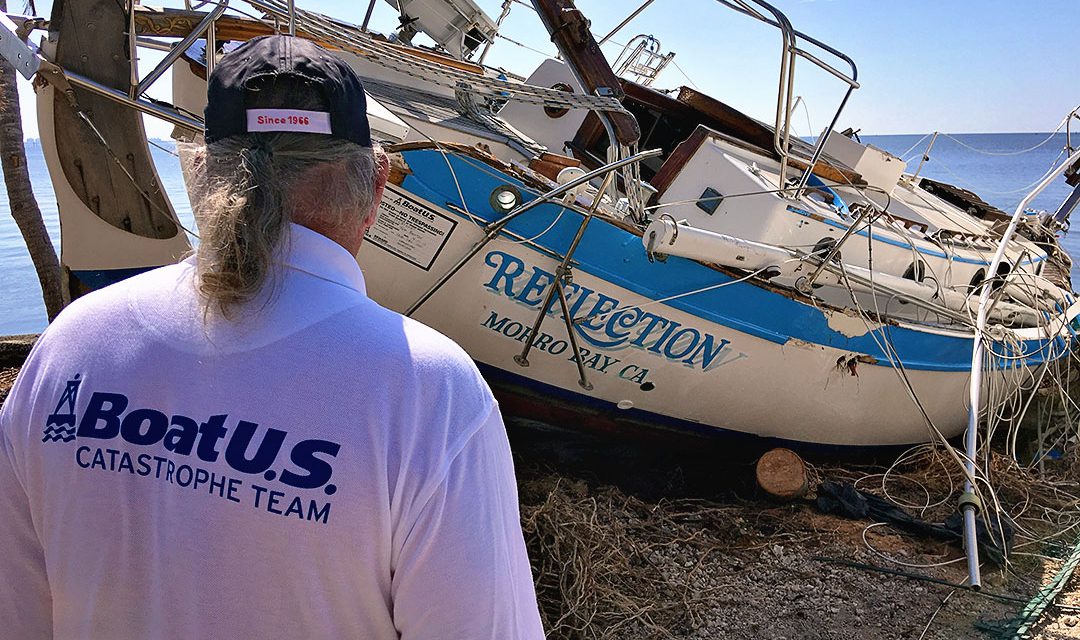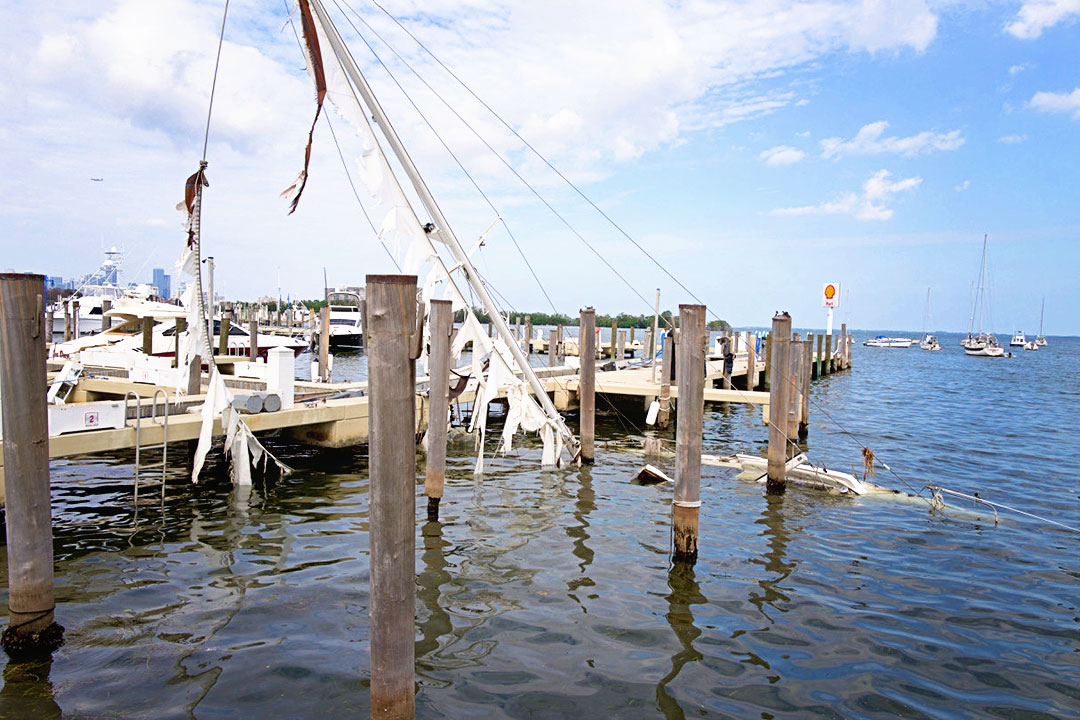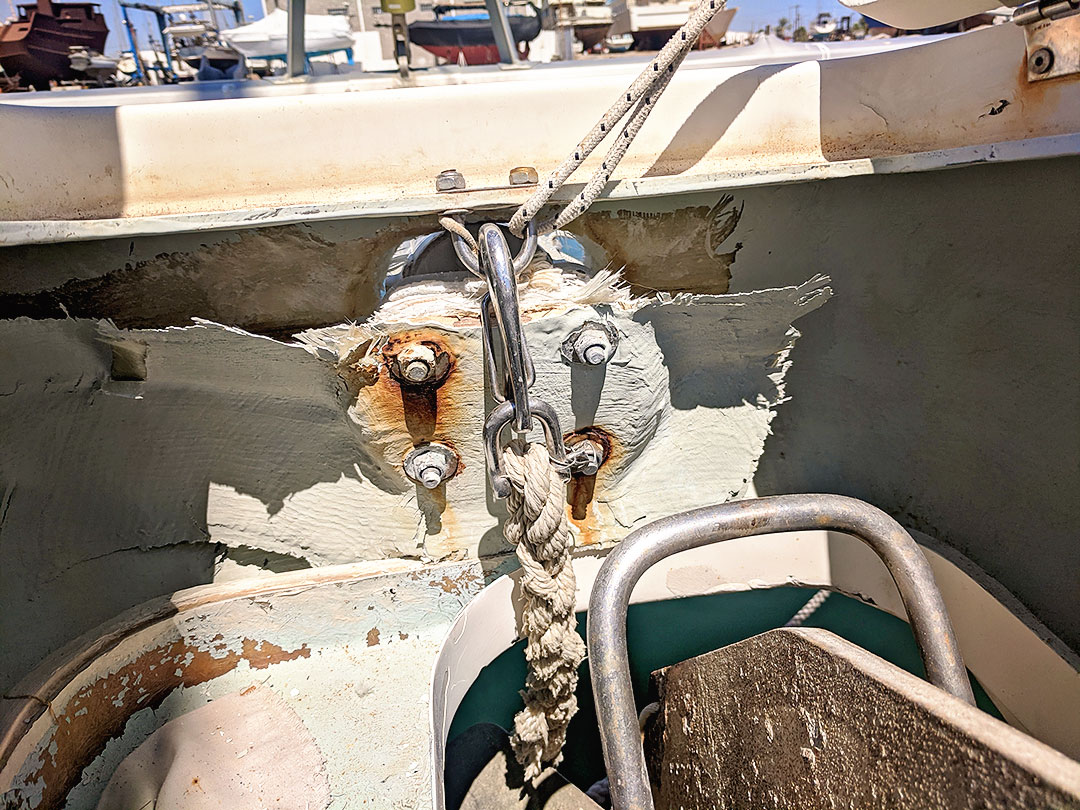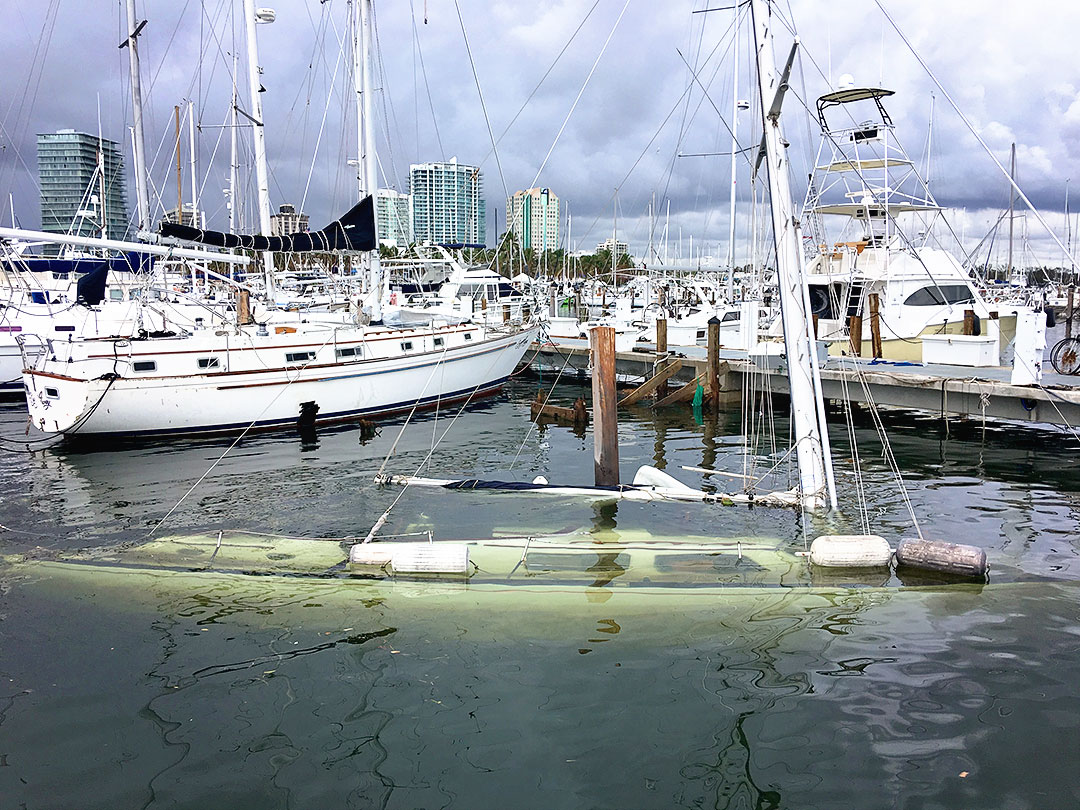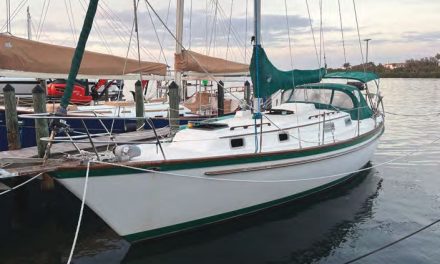Navigating turbulent insurance waters calls for planning, preparation, and patience.
Issue 144: May/June 2022

You’ve never made a claim, yet your insurance carrier just dropped you. You’ve just received an eye-popping renewal quote. Your premium went up 50% for less coverage, and now the company wants a survey after only two years. You’ve spent time and treasure upgrading and refitting a solid, older boat, and you’re struggling to find insurance for it because it’s past a certain age.
Don’t take it personally. Whether they’re new to the water or long-term boat owners, everybody on the dock seems worried about insurance. How much do you need? Where can you find it? Are you paying a fair price?
The insurance industry has clamped down on marine insurance. More extreme and frequent storms have increased catastrophic events; new, inexperienced boaters who hit the water during the pandemic increased accidents and claims. Number crunchers came to the conclusion that insuring older boats was a money-losing proposition. Boat owners—especially those with vessels over 40 years old—are feeling the effects.
The great insurance reckoning hit sailors like an accidental jibe, leaving us to make peace with a grim reality: Insurance is hard to find and harder to keep. So, where do we turn to adequately and properly insure our boats?
Call the Pros
We may naturally want to do everything–or as much as we can–ourselves, but collecting insurance quotes for an older boat is no DIY project.
In fact, filling out forms on websites to compare quotes can undermine your efforts; only a handful of companies insure older boats, and a flurry of requests for the same boat will clog the system and annoy underwriters. Without knowing what underwriters are looking for, your answers might trigger automatic rejection, and once a carrier turns you down, you won’t get a second look.
In this case, an agent is your best resource. Marine insurance specialists maintain longstanding relationships with dozens of A-rated (or better) underwriters. They know who insures cruising sailboats, lithium-ion batteries, and over-40 boats. They have access to surplus and special lines for boats in unusual circumstances.
Two months before you need coverage is the ideal time to start looking for it, says Susan Waters of Florida-based International Waters Insurance Services. “That gives me time to get more than one quote, answer your questions, negotiate on your behalf with the underwriters, and for you to get a survey or supply more information if required.”
“Generally, insurance for older boats is harder to come by,” says Gary Golden, director of Virginia-based Manifest Marine. “Strength comes from knowing who to go to, how to present it properly.”
Even then, he can’t predict the cost. “Each case is so unique I have to start from scratch with each one,” he says. “Sometimes I’ll get four quotes within $100. Sometimes I’ll get seven and none within $500 of each other.”
As the National Association of Boat Owners (also a good source for finding an agent) states on its website: “The bottom line is not the amount of your policy premium, but how much you will collect at the time of loss.”
Going Shopping?
All quotes–new or renewal–are only good for 60 days. Owners of older boats whose premiums just keep increasing may feel an urge to shop around for a less-costly option. For those who already have insurance, this strategy may not pay off. John Wenz, a surveyor and marine insurance specialist with 35 years’ experience, cautions: “If you’ve been with an insurance company for a long time, you’ll end up paying a lot more with another company.”
Instead, sit down with your agent. Hugo Hanham-Gross of Hanham Insurance Agency recommends emailing your agent two months before renewal with two questions: Is our premium fair? If it’s not competitive, is there anything we can do to lower it?
Boat insurance is customized, based on your choices. Your policy may have coverage you don’t need anymore. Ask about changing depreciation, deductible, insured value, and limits on liability and navigation.
For a new policy, assume from the get-go that you will need a survey. You’ll want a sailing résumé, too. The folks who write policies want to know everything about your boat and you, including previous boats you’ve owned, what sailing or boating education you have or courses you have taken, and whether your driver’s license has been suspended. Until you’ve established a track record with them, the less experienced you are, the more you’ll pay.
“Underwriters typically have hard and fast rules on what age boat they are willing to insure,” Waters says. “They are either willing to cover the 40-old boat, or they are not. The credentials, certificates, training, experience simply affect the premium after the decision is made to offer a quote.”
Hull Insurance
Hull insurance policies have two sections, hull and third-party liability (aka liability). The hull section describes the coverage for your boat and the boat’s value. Policies describe insured value as either agreed hull value or actual cash value. Agreed hull value is determined by market value and condition at the time you apply. Once the agreed number is on paper, it doesn’t fluctuate.
Actual cash value is fuzzier. It refers to market value at the time of loss, more like a car’s Blue Book price. The appeal of actual cash valuation is a lower premium, but it also risks less compensation.
For instance, a boat worth $200,000 today depreciates at 2% each year. After five years, the boat is totaled in an accident. For a boat assigned an agreed hull value of $200,000, the owner would probably collect the entire amount. If the boat had been insured for actual cash value of $200,000, insurance would re-evaluate its condition and the market at the time of loss. They’d likely depreciate it 10% ($20,000) and offer current market value of $180,000.
Most clients prefer agreed hull value, says Golden. “It’s hard to prove your boat’s condition when it’s on the bottom.”
Catastrophes are why you carry hull insurance, what most sailors think of as the repair and replacement kitty. In a total loss, you don’t pay a deductible (usually between 1 and 5% of hull value). As long as the loss is covered, you’ll likely receive your insured hull value.
But in most accidents, boats are not completely destroyed, they’re damaged. The owner files a claim for a partial loss. That’s where it gets complicated. Hull insurance doesn’t replace new for old, and old boats are expensive to repair. Parts are often obsolete. Modern versions of electronics, engines, or even a mast may cost 10 times the original. You’ll be on the hook for your deductible––but how much more will you have to shell out for repairs?
Beth Leonard, former Technical Services Director for BoatU.S., says that depends on each damaged part’s depreciation rate (listed in your policy), anything from 2 to 50% per annum.
“If you hit an underwater rock and demolish your new outboard, you’ll want a new one,” she says. “Depending on your policy provisions, your policy should pay for it, less your deductible. But if you hit that same rock with a 12-year-old outboard, it might not be reasonable to expect the insurance company will buy a brand new one. The claim settlement on a 12-year-old outboard will include your deductible and depreciation to reflect its age.”
If the damage is repairable, there’s a cap on compensation. When repair estimates approach 80% of the policy’s hull value, a partial loss is likely to be declared a constructive total loss, different from a total loss in name only.
Liability
Say you’re easing into your slip when a big gust hits. You struggle to keep control of the helm. A guy on the dock rushes to help fend off and gets his hand between the boat and a piling. A second gust hits and pushes your boat harder, crushing his hand.
No matter how much we want to believe we are safe on the water, boats can hurt or kill people. If your boat causes loss of life or disability, you’re wide open to losing everything. Third-party liability insurance, also known as liability or protection and indemnity, protects your assets. It covers bodily injury, property damage, third-party liability, medical payments, uninsured boaters, and salvage/wreck removal.
Coverage should include containment and clean-up expenses resulting from oil pollution or contamination your boat causes. Emergency towing and assistance reimburses you for the costs that you incur when you need emergency assistance for your boat.
For boats without hull coverage, liability is essential (See sidebar “What is Self-Insurance?).
It’s a rare U.S. or foreign marina or yard that will admit you without $300,000 to $500,000 of liability. Their own insurance requires them to keep proof of yours on file.
Words Matter
Each policy is a contract unique to the vessel and its operator containing specific exclusions, restrictions, definitions, and conditions. Every claim is investigated and settled based on specific policy language. All-risk means a risk is covered unless specifically excluded, so pay attention to exclusions.
Your policy won’t cover you outside stated navigation limits, but let’s say one day you sail beyond them. Nothing happens, and you come home safe and sound. Now that you’re back, you’re covered, right?
Maybe not. Were the limits warranted or excluded? Excluded means you aren’t covered when you misbehave. Warranted means you promise never to misbehave; violation can void your policy.
The policy may pay for damage to your outboard but not theft, restrict where and when you can sail, stipulate a minimum age for extra crew, exclude named windstorms, and proscribe many more activities. Perhaps the company says they’ll deduct salvage and wreck removal costs from your check. Are medical payment limits per injured person or per incident? All of these details are worth discussing with your agent.
Policies routinely exclude failures caused by wear and tear, or consequential damage, an issue of concern for older-boat owners and DIY sailors.
Here’s the current Geico/BoatU.S. language, thanks to Kerry Gonzalez, CEO of AMG International. “Coverage will not apply to any loss, damage or expense caused directly or indirectly by: Incomplete, improper or faulty repair, maintenance or renovation.”
This means if damage is caused by a botched repair or a part failure, like a hose clamp or a through-hull, it’s not their problem.
A few years back, Geico/BoatU.S. introduced an exclusion to the consequential damage exclusion, then offered supplemental coverage for it. For an extra fee, it covers a host of failure causes, from rats to corrosion to stray electrical current. Leonard offers an example: “If a worn or corroded electrical wire caused a fire, the damage to your boat from the fire would be covered even though it resulted from wear and tear or corrosion.”
Simply put, Geico/BoatU.S. created an exclusion to offer it as extra coverage. Other companies were forced to follow suit.
Language matters, and insurance-ese can be confusing. Once you have a policy or quote in hand, read the fine print–preferably before you sign–and ask your agent questions.
The bottom line? Read your policy word for word and understand its fine print. That’s about as fun as cleaning the bilge, but just might keep your dream afloat.
Christine Myers cruised more than 65,000 miles on two Amel SuperMaramu 2000s, first while raising three kids aboard Delos, then as captain of Hanalei. She blogs about adventures at sea at bychristinemyers.com. The author is not an attorney or marine insurance specialist. This article is meant to inform, not advise.
Thank you to Sailrite Enterprises, Inc., for providing free access to back issues of Good Old Boat through intellectual property rights. Sailrite.com


